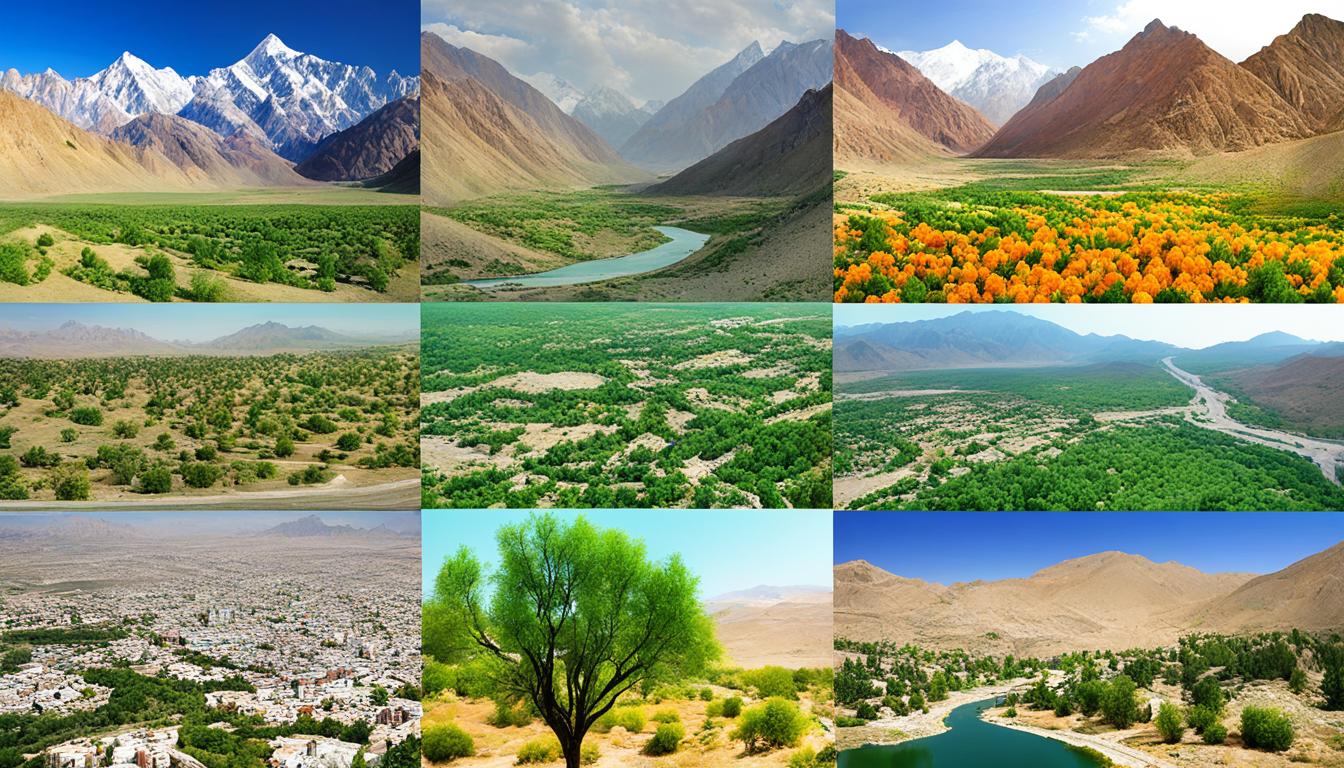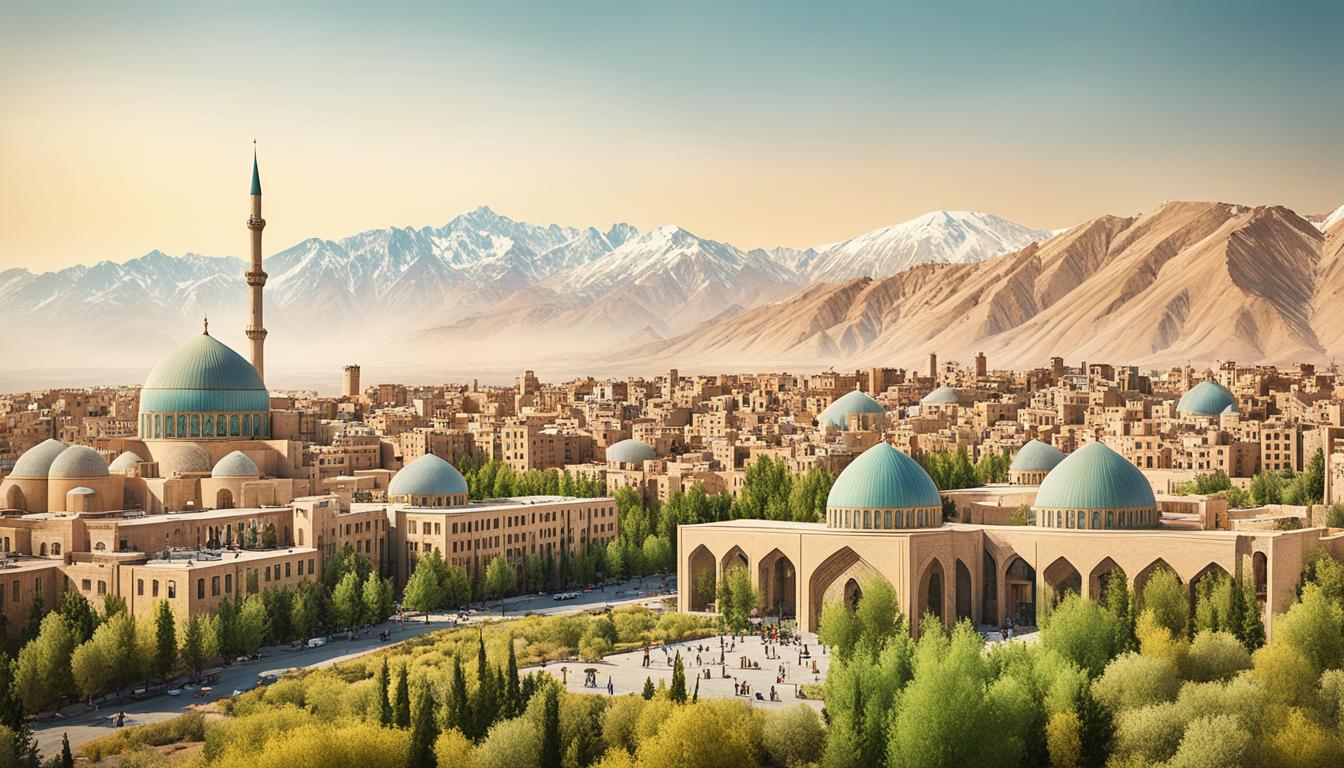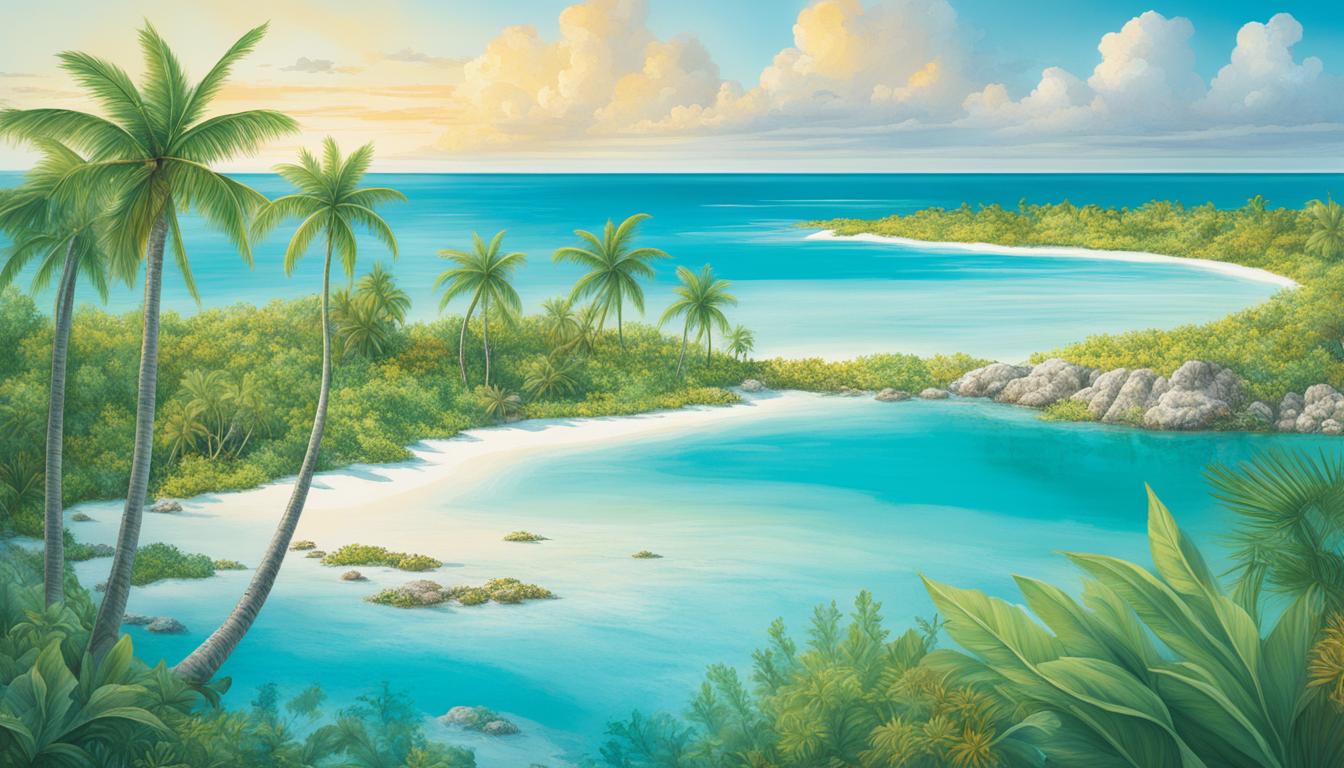Palau Biodiversity and the Built Environment
Did you know that Palau, a small island nation in the western Pacific Ocean, is home to over 1,200 species of plants, with more than 860 of them being native? This remarkable biodiversity extends to Palau’s marine environment, which boasts over 350 species of hard coral, 200 species of soft coral, and more than 1,300 species of reef fish. However, the biodiversity of Palau is under threat from climate change, urbanization, and the impacts of El Niño events. Conservation efforts and sustainable practices are crucial for preserving Palau’s unique ecosystems and ensuring the long-term sustainability of the built environment.
Key Takeaways:
- Palau’s biodiversity is characterized by over 1,200 species of plants and a diverse range of marine species, including corals and reef fish.
- Climate change, urbanization, and El Niño events pose significant threats to Palau’s biodiversity.
- Conservation efforts and sustainable practices are essential for protecting Palau’s ecosystems and the built environment.
- Palau’s natural resources need to be preserved to ensure the long-term sustainability of the country.
- Palau’s urban development strategies should prioritize green initiatives and eco-friendly architectural design.
Endemic Species of Palau
Palau, with its rich biodiversity, is home to a diverse array of endemic species that contribute to the uniqueness of its ecosystems. These endemic species are native to Palau and are found nowhere else in the world. They play a vital role in maintaining the delicate balance of the island’s ecology.
Among the endemic species in Palau, there are numerous endangered plant species that are at risk of extinction. Currently, there are ten known endemic vascular plant species in Palau that are categorized as endangered, threatened, or vulnerable. These plants face numerous threats, such as habitat loss and climate change, which necessitates conservation efforts to ensure their survival.
Palau is also home to several endemic bird species, which add to the avian diversity of the island. With 21 endemic bird species, including the critically endangered Palau Megapode, Palau boasts a vibrant bird population. However, these bird species are particularly vulnerable to climate change and the destructive forces of typhoons. Urgent conservation measures are needed to protect these endemic bird species from further decline.
Preserving the endemic species of Palau is of utmost importance for maintaining the unique biodiversity of the island. By conserving these species, we not only protect the intrinsic value of Palau’s natural heritage but also ensure the continued ecological balance and sustainability of the island’s ecosystems for future generations.
Endangered Plant Species in Palau:
| Scientific Name | Common Name | Status |
|---|---|---|
| Asplenium daucifolium | Daucifolium Spleenwort | Endangered |
| Cycas nummularis | Numularis Cycad | Endangered |
| Drypetes palauensis | Palau Drypetes | Threatened |
| Hopea palauensis | Palau Hopea | Vulnerable |
| Negesia remyi | Remypress | Endangered |
Endemic Bird Species in Palau:
| Scientific Name | Common Name | Status |
|---|---|---|
| Ptilinopus pelewensis | Palau Fruit-Dove | Vulnerable |
| Coccyzus klaas | Palaun Koel | Vulnerable |
| Gymnomyza erythrozonia | Pohnpei Mountain Starling | Threatened |
| Ptilinopus huttoni | Hutton’s Fruit-Dove | Endangered |
| Aplonis pelzelni | Dusky Starling | Endangered |
Images of Palau’s endemic species:
Marine Biodiversity of Palau
Palau, nestled within the Coral Triangle, boasts a treasure trove of marine biodiversity. The Rock Island Southern Lagoon, a designated World Heritage Site, is renowned for its abundant marine life and pristine coral reefs. Palau’s marine ecosystem is home to over 400 species of hard corals, 300 species of soft corals, and more than 1,500 species of fish.
This diverse marine environment supports a rich tapestry of life, with each species playing a vital role in the intricate balance of the ecosystem. From vibrant coral formations to colorful reef fish, Palau’s marine biodiversity is a sight to behold.

“Palau’s coral reefs are not only visually stunning, but they are also crucial for the survival of many marine species. It is our responsibility to protect and conserve these fragile ecosystems.” – Marine Conservationist
To safeguard the future of this marine biodiversity, Palau has implemented ongoing conservation efforts. These initiatives focus on the protection of coral reefs, the promotion of sustainable fishing practices, and the education and awareness of marine conservation.
Conservationists work tirelessly to monitor the health of the coral reefs, identify threats, and implement strategies to mitigate any adverse impacts. The preservation of Palau’s marine species and habitats is of paramount importance to ensure the long-term sustainability of these unique ecosystems.
Marine Conservation Initiatives in Palau
Palau’s commitment to marine conservation is evident in its various initiatives and marine protected areas. The Palau Marine Sanctuary, established in 2015, covers an area of 500,000 square kilometers, making it one of the largest fully protected marine areas in the world.
Furthermore, the establishment of the Palau Protected Areas Network (PAN) aims to ensure the sustainable management and conservation of Palau’s marine resources. PAN encompasses a network of protected areas, including marine sanctuaries, to safeguard critical habitats and maintain ecological balance.
Through these conservation efforts, Palau strives to create a harmonious relationship between human activities and the marine environment. By promoting responsible tourism, sustainable fishing, and community involvement, Palau sets an exemplary model for marine conservation worldwide.
Palau’s Marine Biodiversity at a Glance
| Species | Number |
|---|---|
| Hard Corals | 400+ |
| Soft Corals | 300+ |
| Reef Fish | 1,500+ |
Terrestrial Biodiversity of Palau
Palau boasts a remarkable terrestrial biodiversity, with a rich variety of flora and fauna found within its ecosystems. The country’s diverse forests and habitats are home to an array of unique species, contributing to its status as a biodiversity hotspot.
Approximately 20% of plant species in Palau are endemic, meaning they are found nowhere else in the world. These endemic plants play a vital role in maintaining the delicate balance of Palau’s ecosystems. They provide habitats and food sources for numerous animal species, ensuring the overall health and stability of the environment.
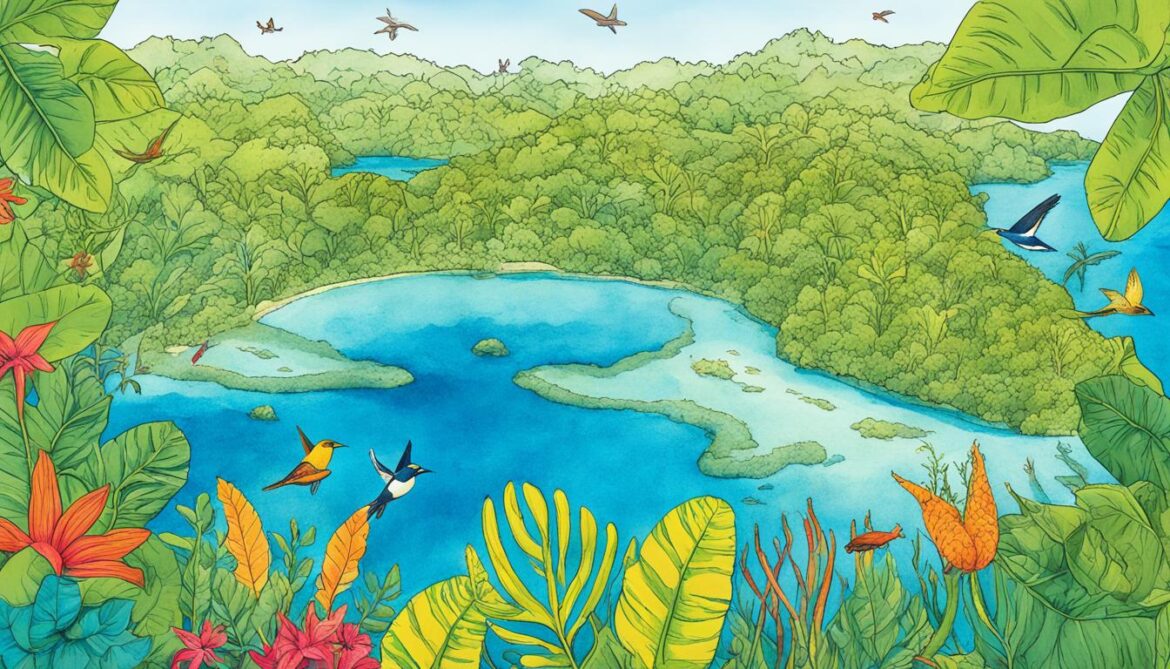
The forests of Palau are particularly important for the conservation of endangered species. One such species is the Palau tree snail (Papustyla pulcherrima), which is endemic to Palau and faces the risk of extinction due to habitat loss and invasive species. The forests also provide a home for the Palaina albata, a critically endangered bird species that relies on the dense vegetation for nesting and foraging.
In addition to these unique species, Palau’s terrestrial ecosystems support a diverse population of reptiles. The islands are home to various reptile species, including bats and rats. These reptiles play crucial ecological roles, such as seed dispersal and controlling pest populations, contributing to the overall health and balance of the ecosystems.
Endangered Species Supported by Palau’s Forests
| Endangered Species | Conservation Status |
|---|---|
| Palau tree snail | Critically Endangered |
| Palaina albata | Critically Endangered |
Palau’s commitment to the preservation and conservation of these species and their habitats is crucial for maintaining the country’s unique biodiversity. Through targeted conservation efforts and sustainable land management practices, Palau aims to protect and restore its terrestrial ecosystems, ensuring the continued existence of its endangered flora and fauna.
Threats to Palau Biodiversity
Palau’s remarkable biodiversity faces several threats that endanger its fragile ecosystems. Climate change, urbanization, and population growth have a significant impact on the country’s unique biodiversity. Rising sea levels and tropical typhoons pose substantial risks, while habitat destruction and pollution from the development of offshore petroleum reserves further exacerbate the situation. The negative consequences of urban expansion, including habitat loss and species displacement, also contribute to the challenges faced by Palau’s biodiversity.
Climate Change and Rising Sea Levels
The effects of climate change, such as rising sea levels, directly threaten Palau’s coastal and marine ecosystems. With its low-lying islands and vulnerable coastal areas, Palau is particularly susceptible to the impacts of climate change. As sea levels rise, coastal habitats are at risk of flooding and erosion, directly affecting the biodiversity they support. The increased frequency and intensity of tropical typhoons brought about by climate change further disrupt Palau’s fragile ecosystems.
Habitat Destruction and Pollution
The development of offshore petroleum reserves in Palau has the potential to cause significant habitat destruction and pollution. These activities disrupt the natural balance and integrity of marine ecosystems, resulting in the loss of habitats for many species. Pollution from oil spills and discharge of pollutants during drilling operations can have long-lasting negative impacts on Palau’s marine biodiversity.
Urbanization and Habitat Loss
The rapid urban expansion in Palau leads to habitat loss and fragmentation, posing a direct threat to the diverse flora and fauna of the country. As cities and towns expand, natural habitats are often converted into urban infrastructure, resulting in the displacement of species and the loss of critical habitats. The destruction of natural habitats diminishes the resources available to the wildlife, making it challenging for species to thrive and survive.
Overall, a combination of climate change, urbanization, and habitat destruction puts immense pressure on Palau’s biodiversity. The conservation of these unique ecosystems is crucial to safeguard not only the natural heritage of Palau but also its ecological balance and the well-being of future generations.
Conservation Efforts in Palau
Palau has prioritized the preservation of its diverse ecosystems through comprehensive conservation measures. Central to these efforts is the establishment of the Palau Protected Areas Network (PAN), which safeguards critical habitats and promotes sustainable resource management.
One significant regional initiative is the Micronesia Challenge, a collective effort among Palau and other Pacific island nations to conserve the region’s natural resources. The goal is to protect 30% of the marine areas and 20% of the terrestrial areas by the year 2020.
Local communities actively participate in natural resource management and protection, ensuring the engagement of stakeholders in conservation initiatives. By involving these communities, Palau fosters a sense of ownership and responsibility for the preservation of its biodiversity.
“We are committed to protecting our natural heritage for future generations, and our conservation efforts reflect the values and traditions of the Palauan people.”
Effective marine conservation strategies have led Palau to establish marine protected areas (MPAs) that safeguard vital habitats and promote sustainable fishing practices. These MPAs play a crucial role in preserving Palau’s marine biodiversity and are carefully managed to balance conservation goals with the needs of local communities.
Sustainable Tourism and Conservation
In recognizing the importance of tourism in Palau’s economy, sustainable tourism practices that support conservation efforts have been implemented. These practices include responsible visitor management, education programs, and sustainable infrastructure development. By promoting sustainable tourism, Palau ensures the protection of its natural resources while providing unique experiences for visitors.
To further emphasize the significance of conservation, Palau has implemented educational programs that raise awareness among residents and visitors alike. This knowledge-sharing approach fosters a deeper understanding of the value of biodiversity and the collective responsibility to protect it.

The Benefits of Conservation
Palau’s commitment to conservation measures has yielded numerous benefits. By ensuring the preservation of its biodiversity, Palau maintains the ecological balance of its ecosystems, safeguarding the abundance and diversity of its marine and terrestrial species.
Conservation efforts also contribute to the resilience of Palau’s ecosystems in the face of climate change and other threats. Protected areas act as refuges for species, enabling their survival and facilitating the recovery of populations affected by environmental changes.
Furthermore, the conservation initiatives in Palau have positioned the nation as a global leader in sustainable practices. Palau’s success serves as a model for other countries, inspiring them to prioritize conservation and adopt similar measures to protect their own natural heritage.
“Palau’s commitment to conservation illustrates the power of collaboration and demonstrates that sustainable practices can successfully coexist with economic development.”
Through the implementation of comprehensive conservation measures, Palau ensures the long-term viability of its rich biodiversity. By balancing environmental protection and sustainable development, Palau remains a shining example of effective conservation in action.
The Role of Palauan Culture in Biodiversity Conservation
Palauan culture holds a deep connection to biodiversity and plays a crucial role in conservation efforts. The traditions and practices of the Palauan people contribute to the sustainability and harmonious relationship between Palauans and the natural environment.
Throughout generations, Palauan culture has embraced habitat modification and the utilization of green spaces in urban areas to support biodiversity. This includes the creation of traditional gardens and the preservation of sacred sites that serve as important habitats for endemic species.
By incorporating traditional practices into contemporary conservation strategies, Palauan culture highlights the importance of maintaining a balance between human activities and the preservation of biodiversity. These practices not only contribute to the protection of Palau’s unique ecosystems but also nurture a sense of stewardship and responsibility towards the natural world among future generations.
Preserving Traditional Knowledge
One of the key aspects of Palauan culture is the transmission of traditional knowledge from elders to younger generations. This knowledge encompasses a deep understanding of the natural environment, including the identification of plants, animals, and their ecological roles.
Preserving and promoting traditional knowledge is essential for successful biodiversity conservation in Palau. This involves creating opportunities for the transfer of knowledge, supporting cultural education programs, and empowering local communities to participate in natural resource management and protection efforts.
Raising Awareness
The role of Palauan culture in biodiversity conservation also extends to raising awareness among staff, suppliers, and the broader community. By emphasizing the importance of biodiversity and the interconnectedness of all living beings, Palauan culture encourages individuals to take an active role in conservation efforts.
Through storytelling, art, and community events, Palauan culture fosters a sense of environmental responsibility and inspires collective action towards the preservation of Palau’s natural heritage.
Quotes from Palauan Elders
“Our traditions teach us that we are part of nature, not separate from it. We have a sacred duty to protect and care for the land and sea that sustain us.”
“By respecting our traditional practices and embracing nature’s teachings, we can ensure a future where Palau’s biodiversity thrives and our cultural heritage remains strong.”
| Traditional Practices in Palauan Culture | Impact on Biodiversity Conservation |
|---|---|
| Creation and maintenance of traditional gardens | Preservation and propagation of endemic plant species |
| Protection of sacred sites | Preservation of critical habitats and ecosystems |
| Responsible fishing practices | Sustaining fish populations and maintaining healthy marine ecosystems |
| Taboos and resource management systems | Regulating the use of natural resources to ensure sustainable harvest |
Palauan culture plays a significant role in the conservation of Palau’s rich biodiversity. By embracing traditional practices, raising awareness, and preserving traditional knowledge, Palauans demonstrate their commitment to safeguarding the natural wonders that make their country unique.
New Regulations and Biodiversity in the Built Environment
New regulations are set to revolutionize the construction industry’s approach to biodiversity conservation. One of the groundbreaking measures is the implementation of mandatory biodiversity net gain. The concept of biodiversity net gain aims to mitigate the negative impact of development on biodiversity and, ideally, result in a positive outcome for biodiversity after completion.
The construction industry will be required to comply with specific regulations that include achieving a minimum of 10% net gain in biodiversity. Additionally, developers must secure habitats for a minimum of 30 years, ensuring the long-term sustainability of biodiversity in the built environment.
Furthermore, raising awareness and adopting practical approaches contribute significantly to enhancing biodiversity in construction projects. Implementing green spaces within buildings and modifying habitats to accommodate diverse species are vital steps in promoting built environment conservation.
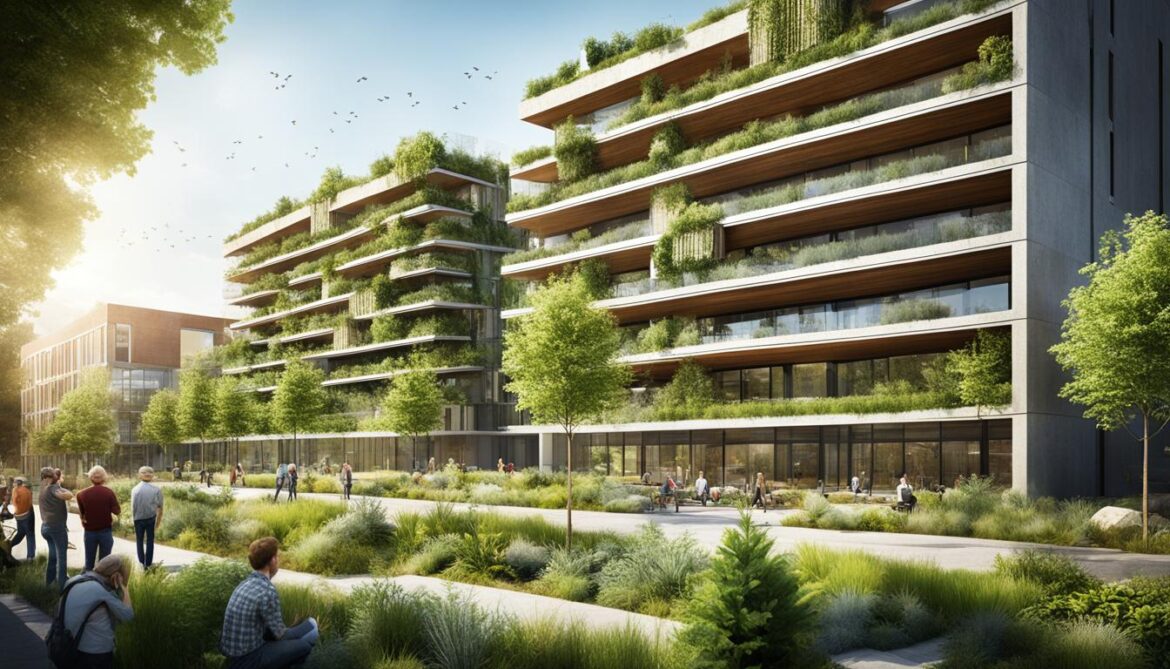
“The construction industry has a unique opportunity to not only comply with the new regulations but also become champions of biodiversity conservation in the built environment.”
Changing the Landscape: Biodiversity Net Gain in Action
| Project | Net Gain in Biodiversity (%) | Habitats Secured (years) |
|---|---|---|
| Green Heights Residential Complex | 15% | 40 |
| Ecotopia Office Park | 12% | 35 |
| Nature’s Haven Shopping Centre | 8% | 30 |
Table: Examples of projects implementing biodiversity net gain and securing habitats for the built environment. These projects show varying levels of net gain achieved and the corresponding years of habitat protection.
The introduction of these regulations marks a paradigm shift in the construction industry, fostering a proactive approach towards conserving biodiversity. By embracing these new guidelines and implementing sustainable practices, the industry can play a pivotal role in safeguarding the natural environment and promoting the well-being of both the built and natural worlds.
Global Biodiversity Targets and Impact of the Built Environment
The UN Biodiversity Conference plays a fundamental role in setting action targets for the conservation and restoration of biodiversity. These targets serve as vital guidelines for countries and organizations around the world to address the pressing issues of biodiversity loss and habitat degradation. By adopting these targets, governments and businesses can actively contribute to the protection and sustainable use of ecosystems.
Businesses operating in various industries will be required to assess and report on their impacts on biodiversity. This step is crucial in identifying areas where negative impacts can be minimized and positive conservation efforts can be implemented. Through transparency and accountability, businesses can contribute significantly to the overall goal of preserving biodiversity for future generations.
The built environment, including architecture and urban design, has a significant impact on biodiversity. By adopting sustainable and eco-friendly practices, the built environment can actively contribute to the conservation and enhancement of biodiversity. Habitat modification techniques, such as green roofs and vertical gardens, can create additional spaces for plants, insects, and other organisms in urban areas. Additionally, utilizing existing space in buildings, such as installing bird nesting boxes or bat roosts, can actively promote biodiversity in otherwise limited environments.
Furthermore, practical approaches such as indoor and outdoor planting regimes can significantly enhance biodiversity. Incorporating green spaces within buildings, using native plant species, and implementing sustainable landscaping practices can create habitats and corridors for a wide range of species. These measures, when integrated into architectural design and urban planning, help create a more sustainable and biodiverse built environment.
| Biodiversity Conservation in the Built Environment | Impact |
|---|---|
| Habitat Modification Techniques | Creative approaches to modify urban spaces to support biodiversity. For example, green roofs and vertical gardens create additional habitats for plants and insects in urban areas. |
| Utilization of Existing Space | Transforming unused spaces in buildings to support biodiversity. For example, bird nesting boxes and bat roosts provide habitats for these species in urban environments. |
| Indoor and Outdoor Planting Regimes | Implementing sustainable landscaping practices and incorporating native plant species within buildings to create habitats and corridors for a diverse range of species. |
By recognizing the impact of the built environment on biodiversity and taking proactive measures, we can ensure the conservation and enhancement of biodiversity within urban settings. With a collective effort from governments, businesses, and individuals, we can create built environments that not only fulfill our needs but also contribute to the preservation of the natural world.
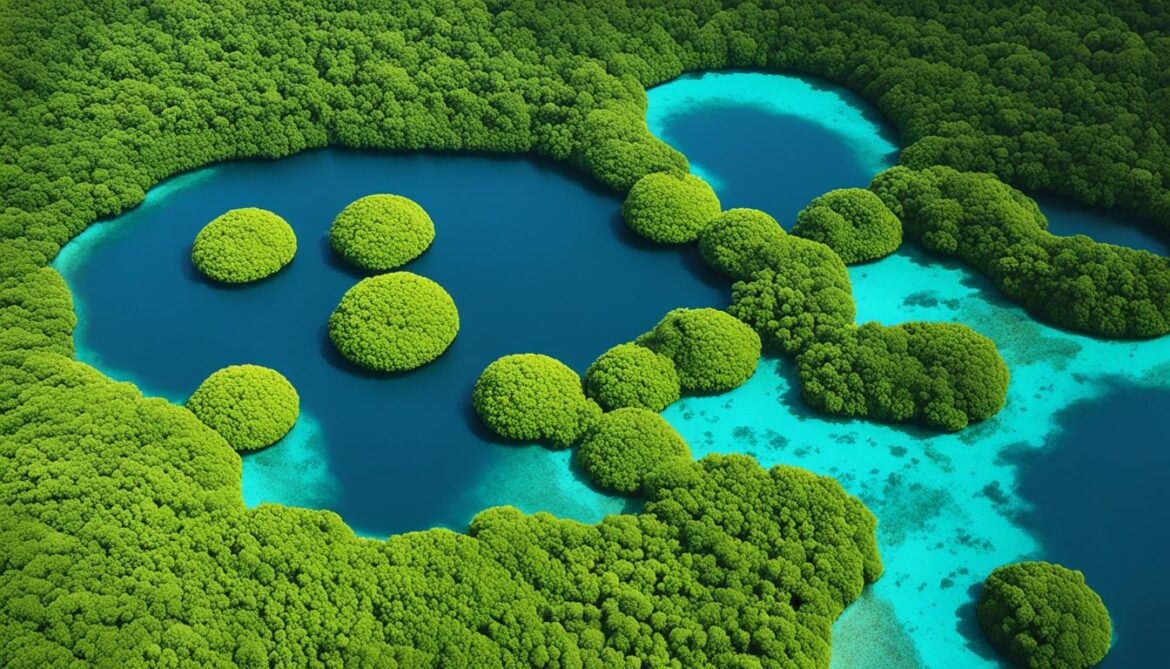
Key Takeaways:
- The UN Biodiversity Conference sets action targets for biodiversity conservation and restoration.
- Businesses are required to assess and report on their impacts on biodiversity.
- The built environment can actively contribute to biodiversity conservation through habitat modification and the utilization of existing space.
- Practical approaches, such as indoor and outdoor planting regimes, enhance biodiversity in the built environment.
Conclusion
Palau, with its remarkable biodiversity, faces numerous threats from climate change and urbanization. However, the preservation of its unique ecosystems and endangered species relies on vital conservation efforts.
One such measure is the implementation of mandatory biodiversity net gain in the construction industry. By ensuring a positive outcome for biodiversity after completion, Palau can protect its valuable natural resources. Sustainability and conservation strategies play a crucial role in safeguarding Palau’s biodiversity for future generations.
Through embracing sustainable practices and raising awareness about the importance of biodiversity conservation, Palau can maintain its status as a global leader in environmental conservation and sustainability.
FAQ
What is the significance of Palau’s biodiversity?
Palau is known for its remarkable biodiversity in both marine and terrestrial ecosystems. It is home to a wide range of species, including endemic and endangered plants and birds.
What are some of the endemic species in Palau?
Palau is home to several endemic species, including endangered plants like the Palau tree snail and Palaina albata, as well as bird species such as the critically endangered Palau Megapode.
What is the marine biodiversity of Palau like?
Palau’s marine environment boasts over 350 species of hard coral, 200 species of soft coral, and more than 1,300 species of reef fish. It is renowned for its abundant marine life and pristine coral reefs.
What is the terrestrial biodiversity of Palau like?
Palau showcases a diverse array of flora and fauna in its terrestrial ecosystems. Approximately 20% of plant species in Palau are endemic, and it supports diverse reptile populations, including bat and rat species.
What are the main threats to Palau’s biodiversity?
Palau’s biodiversity is threatened by climate change, urbanization, rising sea levels, tropical typhoons, and the development of offshore petroleum reserves. These factors pose significant risks to Palau’s fragile ecosystems.
What conservation efforts are being made in Palau?
Palau has implemented conservation measures through the Palau Protected Areas Network (PAN) and specific marine protected areas. The Micronesia Challenge is a regional initiative that aims to conserve the region’s marine and terrestrial resources.
How does Palauan culture contribute to biodiversity conservation?
Palauan culture holds a deep connection to biodiversity and incorporates practices that contribute to sustainability and the harmonious relationship between Palauans and the natural environment. Traditional practices include habitat modification and the utilization of green spaces in urban areas to support biodiversity.
Are there any regulations that protect biodiversity in the built environment?
Yes, new regulations such as mandatory biodiversity net gain are proposed to protect biodiversity in the construction industry. Biodiversity net gain aims to limit the impact of development on biodiversity and ensure a positive outcome for biodiversity after completion.
What are the global targets for biodiversity conservation?
The UN Biodiversity Conference aims to set action targets for the conservation and restoration of biodiversity. Businesses will be required to assess and report on their impacts on biodiversity and reduce negative impacts.
How can the built environment contribute to biodiversity conservation?
The built environment can raise the profile of biodiversity through habitat modification and utilizing existing space in buildings. Practical approaches such as implementing indoor and outdoor planting regimes contribute to biodiversity enhancement.



